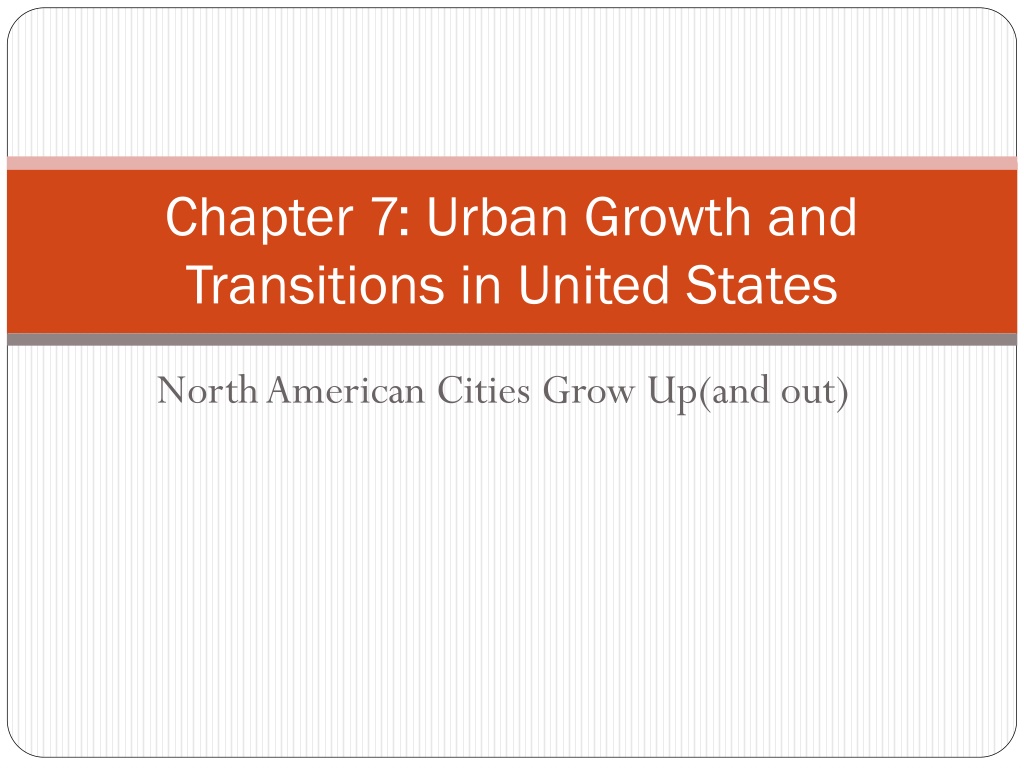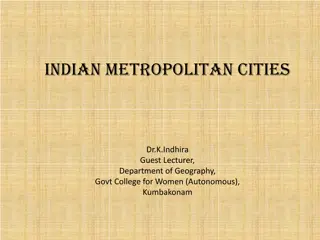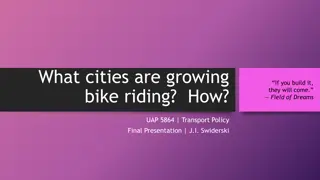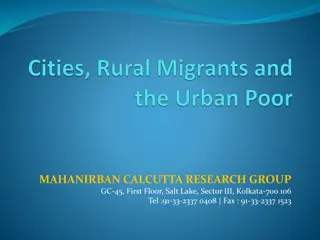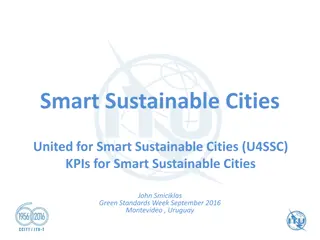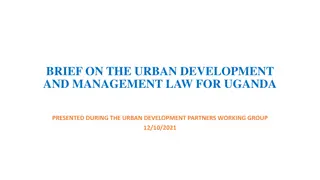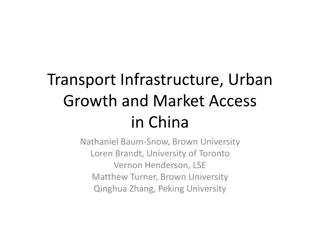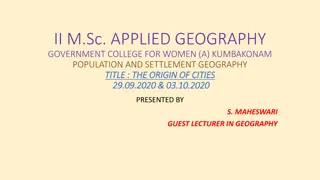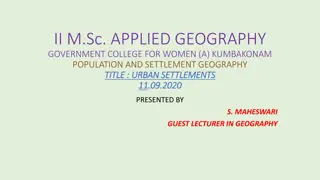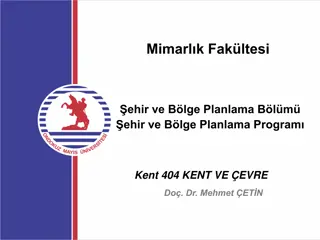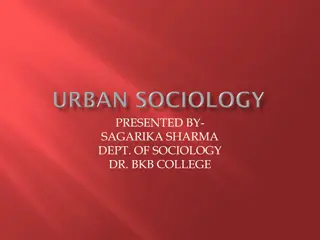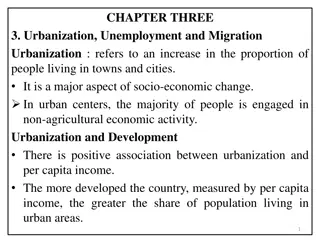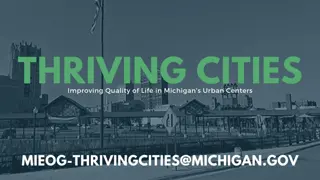Urban Growth and Transitions in United States North American Cities
The chapter explores the stages of capitalism and urbanization in American cities, focusing on the tradition of privatism and factors influencing city building processes. It delves into major settlements and the evolution of cities in the New Nation from 1790 to 1860, highlighting their characteristics and demographic shifts.
Uploaded on Sep 30, 2024 | 0 Views
Download Presentation

Please find below an Image/Link to download the presentation.
The content on the website is provided AS IS for your information and personal use only. It may not be sold, licensed, or shared on other websites without obtaining consent from the author. Download presentation by click this link. If you encounter any issues during the download, it is possible that the publisher has removed the file from their server.
E N D
Presentation Transcript
Chapter 7: Urban Growth and Transitions in United States North American Cities Grow Up(and out)
Stages of Capitalism and Urbanization Stages of Capitalism Stages of Capitalism Stages of Urbanization Stages of Urbanization Mercantile-colonial period Industrialization period Monopoly Capitalism Global capitalism period Colonial period:1630-1812 Industrial Period: 1812- 1920 Metropolitan Period: 1920-1960 Multi-centered Expansion: 1960 to today
Privatism To describe the American tradition of privatism is not to summarize the entire American cultural condition the tradition of privatism is, however, the most important element of our culture for understanding the development of cities. The tradition of privatism has always meant that the cities of the United States depended for their wages, and general prosperity upon the aggregate successes and failures thousands of individual enterprises, not upon community action. It has also meant that the physical form of American cities, lots, houses, families, and streets, have been the outcome of the real estate market of profit seeking builders, land speculators, and large investors (Warner 1968 :4).
Factors in City Building Process City building in the United States exaggerates aspects of organization including (1) lack of walls or fortifications around cities; (2) real estate development as a major component in the economy of capitalism (3) ideology of privatism, which limits the role of the state emphasize individual accomplishments as bases of community (4) large- scale immigration and population churning within cities; (5) regional dispersal of Metropolis.
Major settlements Five important English urban settlements had similar characteristics: 1) all were coastal seaports 2) all were commercial cities emphasizing trade and commerce; 3) all had back country to develop 4) all were small, both in population and size. All cities were fundamentally British. Colonial urban influence-as a result of town-based settlement pattern, by 1690 almost 10% of the colonial population is urban; Cities set political as well as social tone, emerging classes became increasingly dissatisfied with British policy. Boston, a center of opposition, was called metropolis of sedition.
Cities in the New Nation: 1790 -- 1860 First U.S. Census in 1790 revealed only 5% of 4 million people live in places of 2500 or more. America s population overwhelmingly rural, this demographic dominance was not reflected in the distribution of power or composition of the leadership groups; Federalist party largely urban-based party representing commercial and banking rather than agrarian interests; Rapid growth of cities after Revolutionary war result of foreign and rural immigration and high rate of natural replacement; estimated each married woman 1794 an average of almost 8 children; combined with European Young adult immigrants national median age of only 16 years in US;
Between 1790- 1860 population doubled every 23 years a rate equivalent to that in some developing countries Rapid growth during period from 1820 and 1860 cities grew at a more rapid rate that at any other time before or since in American history; influence of environmental factors included fact nine cities by 1860 had passed 100,000 mark, eight were ports; New York grew from just over half a million in 1850 to over 1 million in 1880, handling one third of the country s exports and two thirds of imports;
Marketplace Centers Marketplace Centers Before Civil War American cities still retained many preindustrial characteristics. Carbon economy still in a commercial rather than industrial stage, business people primarily merchants sometimes functioning in manufacturing, banking, and speculators; in 1850, 85% of the population was still classified as rural; 64% engaged in agriculture; Separation of workplace in residence so common in contemporary America cities was limited; residences, businesses, and public buildings intermixed with little specialization by area; people lived and worked in same house or at least in same neighborhood; Early American cities well to do tended to live, not on the periphery, but near the center.
Technological developments Technological developments Railroad was crucial in the development of the West, from 1850 on expanded from 9000 to 193,000 miles much of it built with federal loans and land grants; changes in farming technology converted the self-sufficient yeomen into an entrepreneur raising crops for market: still plows mechanical threshers led to shift from self-sufficient to commercial farming; between 1877 and1889 other technological inventions included steel frame buildings, light bulb, electric power lines, electric streetcars, electric elevators, telephone, subways, an internal combustion engine. All led to growth of cities; 19thCentury inventions such as steam elevator and still girded buildings enabled core area to become more densely inhabited;
Any attempt to deal with present-day transportation or pollution problems as to take into account the fact that most American cities were planned and built in the 19thcentury; Quick way of determining earlier boundaries of the city is to note the location of older cemeteries. Cemeteries traditionally place on the outskirts, large cemeteries within present city boundaries effectively show earlier extent of urban growth. Spatial concentration late 19thcentury city was a city of concentration and centralization accentuated by industrialization. Industrialization encourage centripetal rather than centrifugal forces; Manufacturing was concentrated in core area that surrounded central business district and had access to rail and water transportation; low worker pay and limited transportation technology meant workers had to live near factories; separation place of residence and place of work was a lecture only very wealthy in commuting suburbs could afford.
20thCentury dispersion: Metropolitanization While 19th-century technology foster concentration, technologies of last hundred years have fostered metropolitan area dispersion; three technological inventions heavily contributed to this change: telephone, electricity, and transportation advances, especially electric streetcar, the automobile, and truck; at beginning of 20th century, average New York lived quarter-mile from his or her place of work. Half of Chicagoans(over 800,000) lived within 3.2 miles of city center; electric trolleys accounted for 97% of all mileage in 1902, rapid development of outer areas of city and proliferation of new middle-class streetcar suburbs; within one s home along streetcar line, it was possible to live as far as 12 miles from central business district;
Political life Immigrants problems- more than 40 million European immigrants entered the US between 1890 and 1925, first the Irish, later Germans and Scandinavians according to the Midwest after development of steamships and opening of the railroad to Chicago; between 1890 New York had half as many times as Naples, as many Germans as Hamburg, twice as many Irish as Dublin, and two and half times the number of Jews as Warsaw; native-born Protestant Americans suddenly became aware of fact that 40% of 1910 population was foreign, immigrants or the offspring of immigrants. NativebornAmericans tended to view city problems has been the fault of immigrants, frequently Catholic or Jewish, who inhabited central city ghettos.
Expanding Metropolis: Through World War II According to 1920 census, there were for the first time more than 100 million people living United States, majority (51.2%) were urban 1920s witnessed changes in agriculture that accelerated migration to the cities from the rural areas(211) the reduction of farm families led directly to reduction in number people employed in agriculture related sales, services, and processing of agricultural goods in rural areas (211). As farmers turned to machinery, larger capital investment that machinery required and individual farmers had to acquire more acreage and become bigger operators. This meant fewer farm families
Expanding Metropolis: Through World War II It also meant young people would have greater difficulty getting started in farming due to higher investment costs; as a result, more would leave rural areas. Situation was made worse for far, but agriculturally dependent, businesses and occupations because of automobile and improved roads and in relative isolation of these communities. Improve transportation meant businesses no longer had a monopoly on local trade in which they had been dependent(211).
Metropolitanization In the early 1900s cities that we have been discussing like Chicago, Cincinnati, or New York have become centers of sprawling urban growth and extended beyond official boundaries of those places(212). In contrast to 19th-century populations particularly those described by the term walking city, any accounting of urbanization has to take into consideration both central city or core populations and outer city, suburban, and fringe population, who effectively make up total population of integrated urban space
The Automobile Age Car that cost $950 in 1910 for $290 by 1924. Wages were rising during the 1920s so more people could own cars. In 10 years from 1905-1915, the number of registered automobiles increased from 8,000 to 2.3 million. By 1925 there were 17 .5 million, by 1930, 23 million; In 1921 only 13% of roads outside cities were paved. The first federal highway act, passed in 1916 in response to popular and business demands for highways, directed every state to establish a state highway department to plan routes, supervise construction, and maintain roads that federal funds would help to build (214).
The Automobile Age #of people using public transportation continued to decline during the depression years of the 1930s, just as motor vehicle registration continue to increase. The public transportation look to government for support, and was turned down. It was refused because, unlike the subsidized highway system, it was considered a private investment rather than a public good (214). The parking lot and traffic light became ubiquitous features of the cityscape. By 1925 the attraction of the open road was accounting for 24,000 deaths and 600,000 injuries due to traffic accident (215).
Urban trends since World War II Federal government s Role in Suburbanization 1944 Veterans Administration mortgage loans added to other loans available through Federal Housing Administration(FHA), these government guarantees helped to fuel an unprecedented growth in housing industry. Housing starts, numbered only 114,000 in 1944, 937,000 in 1947 and 1.7 million in 1950; (219) Between 1950 and 1960, the number of people who live in metropolitan areas but outside of central cities increased at a rate five times that of Central city population; 1960- 1970, increase was about four times as fast ;
Urban trends since World War II CBD, which had once been at the center of all major urban activities, declined as automobiles continue to replace public transportation. Central city had served as hub of a managed public transport system, traffic management schemes for private transportation generally included efforts to orient traffic away from downtown.(219). The 1956 Federal Aid Hwy. Act set aside $100 billion over a period of 13 years for revision and expansion of interstate highway system; the system was designed to link most major cities with superhighways (219); In Providence Rhode Island between 1955 and 1965, a 10 minute travel zone from city center increased by about 2 miles; the 20 minute zone group from 7 to 14 miles; and 40 minute zone grew from 18 to 25 miles.
U.S. Census Bureau U.S. Census Bureau Metropolitan statistical area (MetroSA) was instituted in 1990. closely clustered cities with a population of 50,000 or more, and add to this population of surrounding county or counties shown by computing patterns and other economic measures to be integrated with the urban core. In 2007 the US Office of Management and Budget added a new category of measurement for smaller urban centers, the micropolitan statistical area(ie MicroSA). These are defined as having at least one urban cluster of at least 10,000 less than 50,000 population, plus adjacent territory that has a high degree of social and economic integration with the core as measured by commuting ties.
Edge Cities Edge Cities Labeled by Joel Garreau to describe pattern of evolving new multiple urban cores found in outer rings of metropolitan areas, usually located beyond old downtowns and found at intersection of two major highways; edge cities are predominantly retail and business centers. According to Garreau, edge cities have to have at least 5 million sq ft. of leasable office space(two thirds of office space in US are in edge cities) and at least 600,000 sq. ft of retail space(more jobs than bedrooms); first out movement starting in 1950s was flow of young ex-GIs and wives to new suburban homes; second beginning in 1960s was out movement of retail trade, especially large department stores that have entered new suburban shopping mall since 1970s.
Edge Cities Edge Cities Third wave from 1970s is out movement of business and manufacturing from inner-city factories and firms to suburban business or industrial parks; importantly, edge cities do not have clearly defined legal edges. They lack municipal boundaries because they're not actually legal entities. They have no civic order or elected government. Being private places they are not governed by municipal legislation, codes, or ordinances. They are private property, and governed, not by elected representatives, but by corporate policy. They are, in effect, private cities.
Malling Malling of the Land of the Land If dominant urban symbol for middle of 20th century was a skyscraper, dominant symbol for beginning of 21st century as a shopping mall. shopping mall is replacing mainstream as core of community. Malls serve social as well as commercial functions. Malls emphasize total predictability.
The Rise of Sunbelt The Rise of Sunbelt Growing southern rim, known as the Sunbelt, extends from Virginia on the east to the states of the South and Southwest, up to California on the west. Houston, with just over 2 million people as of 2006, is the nation's fourth-largest city. Phoenix grew by 35.8%, MSA by 56%; city of Houston by 29.4%, it s MSA by 46.4%; city of San Diego by 25.7%, it s MSA by 37.1%; most rapidly shrinking cities in first decade of the century included many of the heavily industrialized centers: Detroit, Cleveland, Pittsburgh, Flint, and Toledo;
Sunbelt advantage Sunbelt advantage South offered lower land, labor, and energy costs, as well as lower taxes. Federal government policy, from military spending to highway programs, had bestowed disproportionate benefits on cities of southern rim. Sunbelt Disadvantage-Without technology of air conditioning this transformation would have been impossible. The rise of Sunbelt which includes popular destinations for real estate development and tourism, has also led to increased population growth but decreased taxes to help pay for public infrastructure.
Sunbelt Disadvantage- The world commission on Water for the 21st-century cited Colorado River as one of the world s most serious river waters supply problems, along with Egypt Nile and China s yellow River (234). Los Angeles ranked second in polluted air, and among the cities with the worst levels of air pollution in 2008, seven were in the South, five of those in California (235).
